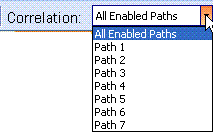

The correlation matrix defines the degree of correlation of a path's fading between the Faders. The number of Faders displayed depends on the number of fader blocks in your configuration.
When you use a standard channel model in a non-MIMO configuration, the firmware automatically populates the correlation matrix in the non-diagonal entries with zeros below the diagonal indicating that no correlation is assigned. Channel correlation is not automatically calculated but may be manually defined if all paths have the same settings, non-zero Doppler frequency, and use Rayleigh fading (not Jakes).

You can view the correlation matrix for an individual path or select all of the paths that are enabled in the Fader Path setups. In some cases, the correlation matrix may display a 0, 1, or be blank.
A correlation coefficient of zero indicates that the fading applied for the selected path or paths is uncorrelated between the two faders.
A correlation coefficient of one indicates that the fading applied for the selected path or paths is identical between the two faders.
A blank cell indicates that the correlation coefficients are not identical for all the enabled paths.
You can edit the entries below the matrix diagonal; this will also populate the corresponding cell (with row, column interchanged) in the upper triangle with the complex conjugate.
Editing a cell of the matrix with All Enabled Paths selected applies the correlation coefficient to all paths that are enabled in the respective Fader Setups.
Editing the correlation coefficient for a specific path number applies the correlation coefficient to all paths with that path number within the correlation group. (Any two paths with different path numbers are independent and thus uncorrelated.)
A valid matrix must have the properties listed below.
The entries are complex numbers that must have a magnitude between [0, 1].
The matrix is Hermitian (equal to its own conjugate transpose). Edits can only be made in the lower triangle of the matrix; the upper triangle is automatically updated with the complex conjugate. (If there is no imaginary part, the transposed coefficient will be the same.)
The correlation matrix must be a  positive
semi-definite
(or positive definite) matrix; the firmware uses the matrix in this form
and a decomposition algorithm to generate the channel correlation.
positive
semi-definite
(or positive definite) matrix; the firmware uses the matrix in this form
and a decomposition algorithm to generate the channel correlation.